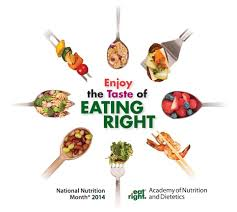Posts tagged ‘national nutrition month’
Healthy Eating Begins at the Grocery Store
The average American visits the grocery store at least twice a week, yet frequently feels there is never anything to eat at home. Since most people have little time to spend at the store, the following tips should help with trips to the supermarket. Eating healthy starts with shopping healthy! Remember, if you don’t buy healthy foods….you won’t eat healthy foods!
- Plan Ahead Planning meals for the week ahead of time will make grocery shopping a faster and healthier experience. Stick to your list in the store rather than coming up with ideas as you shop.
- Shop the Perimeter The best choices are located around the store rather than in the center aisles. The foods found on the perimeter are typically the most fresh.
- Don’t Shop Hungry Grocery shopping while hungry increases the temptation to purchase foods you might normally be able to resist. If you can’t shop right after a meal, be sure to have a snack before heading to the grocery store.
- Compare, Compare, Compare The labeling of many food products can not only be confusing, but also deceiving at times. If you find a product claiming to be reduced, compare it to the original version first. Many times there is little or no benefit to such products.
- Be Smart Remember that grocery stores are mostly concerned with selling foods to the consumer rather than nutrition. Do not be easily influenced by specials and creative labeling. Stick to your list and make smart, healthy decisions.
National Nurtrition Month: Explore New Foods and Flavors
Nutrition professionals are encouraging you to “Enjoy the Taste of Eating Well” by exploring new foods and flavors. Whether you are trying new veggies, whole grains, or creating new recipes to excite your taste buds, you are exploring new foods and flavors.
Here are 3 quick tips for enjoying the taste of healthy eating:
- Color Your Plate with Salad
Enjoy a variety of vegetables including dark-green, red, and orange vegetables on a bed of fresh leafy greens like spinach or romaine. These fresh veggies offer a beautiful touch of color, delicious flavor, and great nutrition. Bell pepper, carrots, cucumbers, and broccoli are great lower carbohydrate veggie choices that will not have a large effect on your blood glucose levels. One cup raw, or half a cup cooked, of these nutritious non-starchy vegetables is considered one serving and contains very few carbohydrates. Now that is food for thought! - Great Grains
Enjoy the taste of eating well by choosing foods with different textures and taste. How? By trying a variety of whole grain foods. The Academy of Nutrition and Dietetics recommends making at least half of your grains whole. To be sure that you’re eating a whole grain food check the ingredients list on the food package. Fiber-rich whole grain foods like 100% whole-grain breads, pastas, tortillas, quinoa, brown rice, and even popcorn are great additions to a balanced healthy diet. It is important to note that these nutritious foods should be eaten in moderation because they have been shown to increase blood glucose. Enjoy the foods you love but eat less. - Power-up with Protein
Choose a variety of foods from the protein group to help build strong muscles and stabilize blood glucose levels. Keep meat and poultry choices lean and low-fat to decrease the amount of saturated fat and calories because diets high in saturated fats raise the levels of “bad” cholesterol in the blood. Explore new tastes by trying lean ground turkey, salmon, tuna, and eggs. Vegetarian sources of protein can include tofu, nuts and seeds. Almonds, cashews, walnuts and pistachios as well as pumpkin, sesame, and sunflower seeds are all commonly eaten nuts and seeds. Minimize your sodium intake, which can help with lowering blood pressure, by choosing unsalted nuts and seeds.
Enjoy the taste of eating right by using these quick tips at your next meal!
DiabetesAmerica Celebrates National Nutrition Month 2014
DiabetesAmerica is ready to help you learn more about healthy nutrition all month long on our various social media sites including Facebook, Twitter and our WordPress Blog. This month we will also provide a chance for you to attend a free, interactive online class about Dining Out with Diabetes on Wednesday, March 21st at 12pm CST. To register for the class, please click here.
On Wednesday, March 14th, we celebrate Registered Dietitian Day and all of the Registered Dietitians on the DiabetesAmerica team who care for patients. Registered Dietitians use their nutrition expertise to help our patients make unique, positive lifestyle changes everyday.
To learn more about National Nutrition Month and Registered Dietitian Day, please visit The Academy of Nutrition and Dietetics website at www.EatRight.org.
Back to the Basics: Nutrition Tips for Healthy Eating
General
• Limit frequency of restaurant dining and fast food
• Limit frequency and portion size of desserts
• Drink 8-11 cups of water daily
• Avoid or limit all beverages with calories
• Make slow, gradual changes to nutrition plan
Vegetables
• Eat a variety of vegetables as frequently as possible
• Try to include all colors throughout the week (red, orange, green, yellow, purple)
• Season with herbs and spices rather than sauce, cheese, butter or oils
• Aim for vegetables to cover half of the entire plate
Fats
• Try lemon juice, vinegar or vinaigrette on salads (For a kick try salsa with fat free sour cream)
• Dip the fork into dressing first to limit the amount, but still add flavor
• In recipes, substitute applesauce for margarine, shortening and oils
• Remove hidden or unnecessary fat: butter on bread, cheese in sandwiches, use mustard rather than mayonnaise
Meats
• Choose lean cuts (loin, round, or flank)
• Avoid heavily marbled meats (brisket, ribs, T-bone, porterhouse, rump/chuck roasts, bacon, regular hamburger, etc.)
• Trim meats before and after cooking
• Remove skin from poultry before cooking
• Buy meats less than 3 grams of fat per ounce or labeled as 90% lean
• Limit egg yolks to 3 per week
• Try two egg whites or 1/3 cup egg substitute in place of one whole egg
Dairy
• Reduce milks stepwise from whole milk to skim or 1%
• Substitute low fat yogurt in place of mayonnaise or sour cream when cooking
Grains
• Aim to choose 100% whole grain breads, cereals, crackers and snacks
• Many grains are low in fat, but only recommended in proper portions
Tips for a Healthy Plate
Make half of your plate fruits and veggies
- Fresh, frozen and canned vegetables all count. For canned vegetables, choose ‘reduced sodium’ or ‘no salt added’ varieties.
Make at least half of the grains you eat whole grains
- Choose breads, cereals, pasta and rice that are 100% whole grain. Be sure to check the ingredients list on packaged foods to find those containing whole grains.
Switch to fat free or low fat dairy products
- Fat free and low fat dairy products have the same amount of calcium and other nutrients as whole milk, with less fat and calories.
Include a variety of proteins in your diet
- Incorporate a variety of protein including seafood, nuts, beans, lean meat, poultry and eggs into your diet.
Be sure to speak with your diabetes educator about an eating plan more specific to your needs. During your next appointment ask your diabetes educator about how to make a healthy plan specific to you and your lifestyle.
*Adapted www.ChooseMyPlate.gov*




